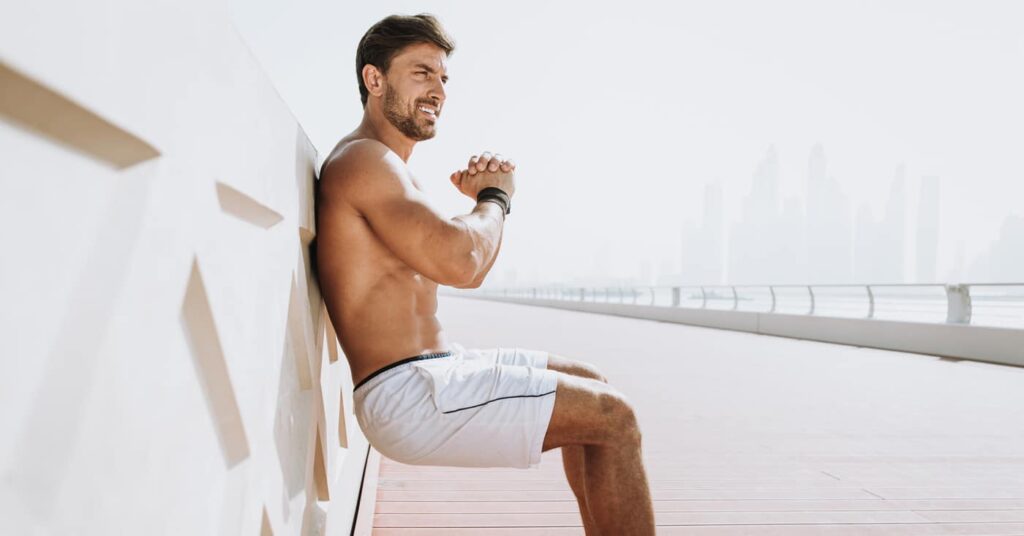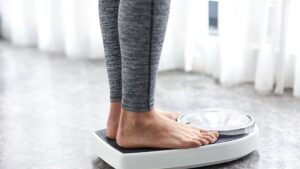Many people believe that almost all exercises must be extremely difficult and physically strenuous, but occasionally the simplest activities can prove most advantageous.
Regarding wall sits, that is unquestionably the case.
Wall sits provide surprising benefits as it pertains to strengthening your thighs, calves and your stomach. They also challenge your mental as well as physical stamina.
This workout is beneficial to you if you’re searching for something simple to learn, but it’s not really that simple, and you’ll start to have trouble after some time.
In essence, this is a plank-like stamina practice that is performed for an extended amount of time rather than in reps.
A wall sit, commonly referred to by the term wall squat, is indeed a deceptively straightforward workout that has numerous advantages.
To perform a wall sit, lean against a wall with your back straight, knees at a 90 ° angle, and thighs aligned to the ground. Maintaining a shoulder-width distance between your legs, keep your feet firmly anchored to the floor.
How to practice wall sits correctly
- Interlude Wall Sits
At the beginning, Wall Sits could allow you to enable you to keep doing them for 15 seconds only. But it’s alright. You can pause for a while and start repeating the Wall Sits.
Begin with three sets for as long as you’re able to tolerate. Gradually increase your reps and length of time. You aren’t required to perform 15 continuous minutes of practicing wall sits. 15 sets of each one minute duration will provide you with the same advantages. If you cannot find the time or motivation to complete your repetitions in a single sitting, then you can split them across the day.
- Maintain a higher wall sit position.
You may lack the endurance to make it all the right down to 90º when you first begin with wall sits. Start off by placing yourself higher up against the wall and bending your knees at a 45 ° angle. When your strength increases, you might make a downward adjustment.
- Put more distance between your feet and the wall.
It may be a little simpler to sit against the wall if you keep your feet further apart in front of your body. By modifying the workout to fit with the stage of your physical endurance, you should still engage your stomach and leg muscles. You will eventually be able to move your feet nearer together to increase the burn.
Steps for Advancing Your Wall Sit
- Without apparatus
- Extend the holding period:
Your heart rate will increase and your muscle-strengthening effects will increase the lengthier you could still maintain the wall sit.
- Lift your toes:
You can elevate your toes whilst trying to maintain perfect wall sit posture to work your leg muscles harder and promote ankle flexibility.
- Reduction of Angle:
This exercise becomes increasingly difficult as you descend. To keep your knees safe, never bend them more than 90 degrees.
- Chair with a single leg:
Lift one leg out in front of yourself while completing a wall sit to intensify the exercise. Be cautious to maintain your buttocks straight. To guarantee equal usage of both legs, keep switching legs. This one-legged workout substantially improves your exercise by adding more strain to your standing quads and hip flexors.
You can also raise one leg across your outstretched leg rather than keeping it straight out in front of you if you find the above method difficult.
- Dynamic Single-Legged Chair:
Holding your stance, you can rotate your lifted leg from one side to the other to put even more strain on your adductor muscles. To properly exercise your muscles, you can however make little circles across both directions.
- Using Equipment
- With Resistance Bands:
To exercise your abdominals and abductor muscles, wrap a resistance band between your knees.
- Weighted Wall Sit
You can enhance your breathing rate as well as calorie burn by holding a weight.
- Wall Sit While Holding a Ball
To increase the stimulation of your adductor muscles, place a ball bounded by your knees.
- Wall Sit Using a Stability Ball
Work on improving your squat strategies by working your muscle groups from various angles while using a stability ball.
- Exercises for the upper body while doing a wall sit
When performing wall sits, add shoulder presses, arm curls and lateral lifts with free weights to increase calorie burn.
How To Exercise Safely And Prevent Injuries
If you feel any joint pain, pay attention to your form and alter your hip, knee and ankle angles. Don’t ever bend beyond 90˚, and during the exercise, maintain a firm core and a firm spine against the wall.
Conclusion
Your endurance, strength, tendons and ligaments and mobility can all be increased with Wall Sits. It’s a great muscle activation workout that benefits your joints. It’s advantageous to reduce chronic knee discomfort brought on by conditions like arthritis and patellofemoral pain (PFP) with regular practice.
Besides, it lowers your risk of developing diseases linked to obesity, like hypertension, diabetes, high blood pressure, kidney issues, etc.
You can perform the wall sit workout anywhere. The only thing primarily you require to start is a wall. Benefits of the amazing wall sit workout can be obtained without spending a lot of money or joining a gym.
FAQs:
- What’s the approximate duration for performing a wall sit?
This differs from person to person. Wall sits can be performed for around 15 minutes by some persons, but only for 15 to 20 seconds by others.
Make the best effort you can, and the workout would still be beneficial to you.
- Do wall seats merit the discomfort they cause?
The brief discomfort or inconvenience of performing wall sits is definitely useful if you place importance on strengthening abs, powerful legs, a strong lower back, as well as healthy knees.
- Even with weak knees, can I perform wall sits?
Probably yes. Wall sits may help reduce knee discomfort over time; consult your doctor to see whether they are a good workout for you.









